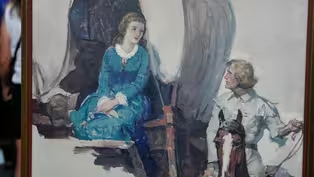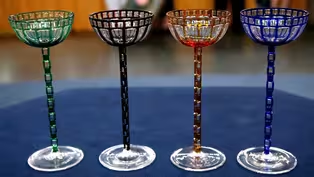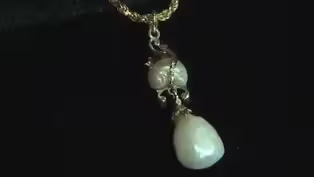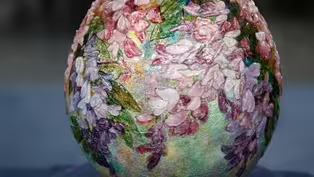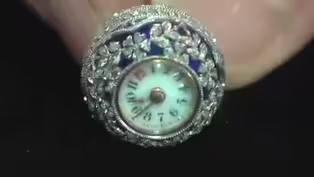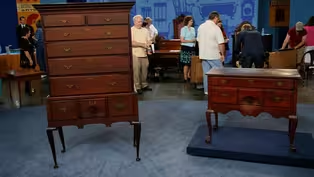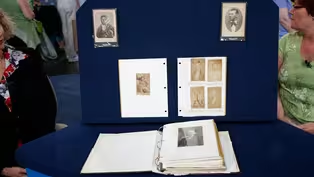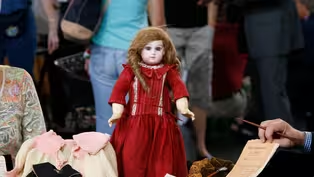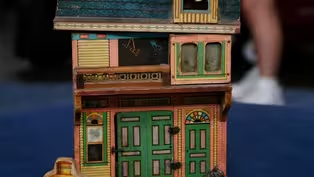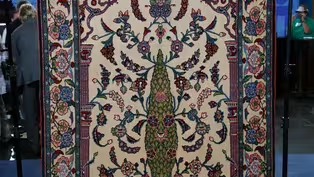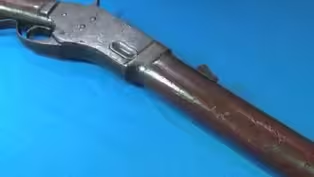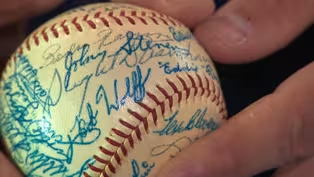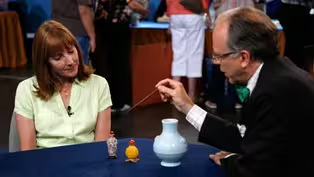
Vintage Orlando, Hour 1
Season 25 Episode 6 | 52m 29sVideo has Closed Captions
Short: See if Sunshine State appraisals still sparkle after 14 years, like one $165K-$200K
See if Sunshine State appraisals still sparkle in the marketplace14 years after ROADSHOW’s visit, including James McNeill Whistler artwork, Presidents Kennedy and Johnson-signed photos, and a Jonas Weber painted box. One is now $165,000-$250,000!
Problems playing video? | Closed Captioning Feedback
Problems playing video? | Closed Captioning Feedback
Funding for ANTIQUES ROADSHOW is provided by Ancestry and American Cruise Lines. Additional funding is provided by public television viewers.

Vintage Orlando, Hour 1
Season 25 Episode 6 | 52m 29sVideo has Closed Captions
See if Sunshine State appraisals still sparkle in the marketplace14 years after ROADSHOW’s visit, including James McNeill Whistler artwork, Presidents Kennedy and Johnson-signed photos, and a Jonas Weber painted box. One is now $165,000-$250,000!
Problems playing video? | Closed Captioning Feedback
How to Watch Antiques Roadshow
Antiques Roadshow is available to stream on pbs.org and the free PBS App, available on iPhone, Apple TV, Android TV, Android smartphones, Amazon Fire TV, Amazon Fire Tablet, Roku, Samsung Smart TV, and Vizio.
Buy Now
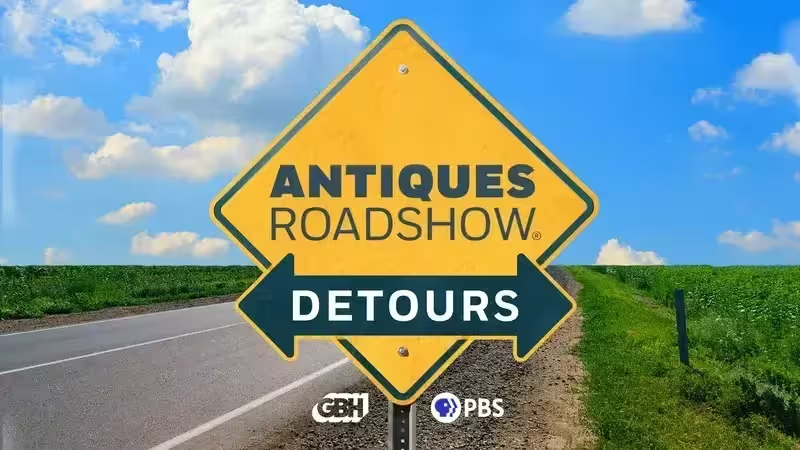
ANTIQUES ROADSHOW DETOURS
Ever wondered what happens to the treasures featured on America’s beloved ANTIQUES ROADSHOW after the cameras leave town? Host Adam Monahan tracks down the juicy afterlives of your favorite finds from PBS’s hit series.Providing Support for PBS.org
Learn Moreabout PBS online sponsorship♪ ♪ If in doubt, leave it a little dirty.
Don't.
Yes-- okay.
We like it a little dirty here.
I knew I shouldn't have thrown away my typewriter.
Darn.
(laughing) Oh, my goodness!
(laughing): I wasn't expecting that one!
♪ ♪ CORAL PEÑA: When "Antiques Roadshow" visited Orlando, Florida, in 2007, thousands of folks from all over the Southeast came to get their treasures appraised.
A lot has happened to the art and antiques markets in the past 14 years, and we wanted to know, where are the prices of those treasures now?
Find out as we take another look at Orlando.
This is a porcelain snuff bottle that I got online on an auction.
What did you pay?
$75.
And what do you think it is?
I hope it's a real old snuff bottle worth more than what I paid for it.
Okay.
And this...
I got as a snuff bottle, or I thought it was a snuff bottle, but when I got it home, we found out it was a match striker.
Okay, and what did you pay for that?
$100.
There's a mark on the bottom that says "Yamanaka," so I think it's worth a little more than what we paid for it.
Maybe... $300?
Okay.
And then this.
And that's a vase that we bought at a local auction, and we paid $200 for it.
And I'm just not sure that it's real.
But it came with a paper that said that it came from a well-known collection.
Exactly.
And on the paper, somebody had dated it to the mid-19th century.
Right.
And I, I'm hoping that's true.
Okay.
Now, the first two here are snuff bottles.
This is enamel-decorated biscuit, which means unglazed porcelain.
And it's wonderful because it's got all these little pierced sections, so it's quite a technically difficult object to make.
Mm-hmm.
The second piece here, which you rightfully said had marks on the bottom and is a match striker, is, in fact-- that's what somebody had used it as-- but it's made of yellowed glass, nicely carved.
The decoration here is quite beautiful.
It's got a pair of dragons that are facing each other that are in an archaistic style.
And the mark on the bottom, Yamanaka, is really quite informative, because Yamanaka was a major dealer in Chinese and Japanese antiques earlier in the century.
Okay.
So, not everything he sold was real, but a lot of it was.
And the quality of this would suggest that it is real.
And the last one is this vase here.
The shape of it is a shape that developed in the 18th century in China.
The color is what's called clair de lune, and as we turn it over, we see that it has a six-character mark here for the Yongzheng period.
So the question is, does it date to that period or not?
So the first piece, the snuff bottle, absolutely is correct.
This is actually worth about, for insurance purposes, around $1,000.
Wow.
This, again, as we turn it over and we look at the underside, we see that it has a mark here which says Yamanaka, and the other mark underneath it actually says "sterling silver."
So it's gilded silver, which is what you want to see on something like this.
Now, it's in good condition.
There's a few little hairline cracks up here at the top, but it's not worth what you had hoped it was worth.
No?
I'm so sorry to say.
It's worth $3,000.
Oh, my gosh.
You are kidding.
Oh, my gosh.
(laughing): No, it's wonderful.
It's a great snuff bottle, all right?
If it weren't cracked, it'd be more.
Okay.
All right, the last one.
Simulating an archaic bronze form from the second century.
This is not from the Yongzheng period.
It's not.
The mark is written correctly.
It's not the right style.
Okay.
The potting and everything suggests that it's closer to the turn of the century.
Very fine-quality potting.
For insurance purposes, I would think it's worth about $5,000.
Oh, my gosh.
Congratulations.
Thank you.
MAN: I know that it's a Tiffany silver vase.
My grandmother took it as collateral on a loan, and the lady couldn't repay the loan, and so it came into my family, and I've inherited it.
How much was the loan for, if you don't mind my asking?
Uh, I believe it was either $300 or $500 back in the '50s.
Now, you said it's made by Tiffany.
Tiffany.
And you know that because?
The mark on the bottom.
Okay.
And we communicated with Tiffany.
We sent them photographs, and, and they weren't able to give us any information because the records from the time period have been, uh, lost.
When do you think this was made?
I believe it's made in the 1860s.
Okay.
Well, in the 1860s, in America and in Europe, we experienced what was called the Renaissance Revival.
And in this, you have use of a lot of different Renaissance motifs.
This is called a Renaissance herm figure.
But notice how it tightly packed it in and how beautifully proportioned it is, not only on the front, but also on the side here, with these winged figures, and on the back.
And on this side, we have the female herm figure.
Now, as we tilt back and look here, we get the Tiffany mark.
It says "sterling silver," and then it has a date letter.
It's a capital C, which would actually make it 1902 to 1907.
Oh.
That much later.
Which is really interesting, because they experienced a little bit of Renaissance Revival at that time, as well.
But this is an amazingly well-made piece.
Given the right amount of time, we might be able to find out who designed this vase, because this was not a general production piece.
Oh, oh, that, that was better... And these are cast, and there is a serial number on the bottom here, which we did look at, as well.
Okay.
And I like to say that that serial number is the key to open the Tiffany archives.
And the Tiffany archives do have records from this time period.
So I think, if we altered strategy a little bit, we might be able to find out who designed this vase.
Now, we were talking about condition a little bit earlier.
Yes, I was wondering about whether I should try and remove the remaining tarnish inside and on the edges.
Okay.
Well, some of it is tarnish, and some of it is factory-applied.
You did clean down some of the texturing here, which makes me believe that some of the factory patina that they put on to create that three-dimensionality is now gone.
Now, in this sense, some things can be reversed.
All right.
But the good rule of thumb is, if in doubt, leave it a little dirty.
Don't.
Yeah.
We like it a little dirty here.
Okay.
But I didn't really do much harm to it.
I don't think you did a lot of harm to it.
Okay, good, good.
So, you know, whew, you don't need to worry about that.
That's a relief.
But, uh, I can guess that you think it's worth a little bit more than the $300 or $500 that your mother-in-law had to pay for it, yeah.
I'm hoping that that's true, yes.
Well, at auction, I would think that this is worth in the $30,000 to $50,000 range.
(laughing): Oh, my God.
That's amazing.
That's a heck of a vase.
Thank...
Thank you.
WOMAN: This tile is one of seven that we have.
My grandmother always had them in her home, propped up on bookshelves.
The designer of this particular tile is Arthur Osborne.
This was made by the J. and J.G.
Low Art Tile Works.
And I remember as a child looking at this one thinking that was my favorite, never thinking I would ever own it.
MAN: I bought it about 35 years ago.
APPRAISER: Okay.
In South Florida.
I was on a vacation with a girl I eventually married and divorced.
We were at a restaurant and this was part of the decor of the restaurant.
It was a Polynesian place.
They were doing a show.
Uh-huh.
And I fell in love with it and bought it for $400 and had it shipped home.
Okay.
And she was a little upset, because she would rather I spent the money on herself.
(laughing) And, um...
Okay.
She left, it stayed, and second wife tried to take it with her when she left, but... And then we have number... Three, yeah ...three.
And she had no claim to it.
She didn't want it at all.
Don't know.
Came from a Polynesian restaurant, so I figured it was some, something from the South Pacific.
Okay, I can tell you the piece is bizarre.
I can't tell you definitively what it is.
I know that it was purely made for decorative purposes.
It may have been made for you.
At the very least, it certainly is a conversation piece.
That's for sure.
APPRAISER: I got to tell you, this is one of the prettiest small watches that have come in in a long, long time.
Now, you got it where?
WOMAN: My great-grandmother's jewelry.
I'm the only daughter of an only daughter of an only daughter.
So I inherited the jewelries down the family.
Meant to be.
Meant to be.
It's what we call a boule watch, "boule", in French, meaning ball.
Okay.
All right?
Um, there were a lot of companies that made them, but not quite this beautiful.
This is all hand-pierced in platinum.
Oh!
And there's little, tiny rose diamonds set in there.
A rose diamond is a diamond with a flat bottom and very few facets on top.
Underneath, you have French, you know, that cobalt blue enamel?
Right?
Now, do you know how to set it?
No.
Yeah, it's a little tricky.
Um, it's what we call a pin-set.
There's a little pin, right here.
You see that?
Barely.
Yeah, it's hard to see.
I had to put my glasses on for you.
Um, you push the pin, and then you rotate this... Oh!
And the time changes.
Uh-huh.
Now, when you release that, now it's ready to wind.
So it's like a little mystery-type thing.
Okay.
The chain would hang off of this bail.
But typically, these chains were just as beautiful as the watch.
Mmm.
Besides having links, it would have little stations of diamonds matching this, and then little stations of enamel going all the way around your neck.
Oh!
In the same blue color?
Oh, absolutely.
Okay.
Yeah, so, you have to really keep your eyes out for a nice chain.
Yes, yeah.
They are out there.
All right.
As it sits right here, I feel it's around $4,000 at auction.
Oh, wow.
I'm speechless.
(laughs) Oh!
My grandmother would be thrilled.
MAN: I was the White House photographer for John Kennedy.
Started the job in inaugural day of 1961.
That's incredible.
And, uh, stayed with him until Dallas.
I was in Dallas during the horrible assassination.
I was in one of the cars in the motorcade, five cars back.
Heard three very distinct reports, sounded like rifle shots.
Didn't know where they came from.
A few minutes later, I was standing outside the operating room door there.
And I had seen Vice President Johnson leaving the hospital.
And I asked where he was going, and someone said, "The president's going to Washington."
So that meant that Kennedy had expired in the hospital.
And I said, "So am I."
And I picked up my camera and went out to the plane.
And when I got there, the press secretary, acting press secretary, Malcolm Kilduff, said, "Thank God you're here, Cecil."
He said, "The president's going to take his oath on the plane "and you're going to have to service the wires with the photograph."
So I took the only photograph of, of the swearing-in that you see.
Incredible.
This is what was happening here, the swearing-in, an image that we all know so well.
It's an icon of the 20th-century imagery.
Most of the people in the picture are all passed away now.
Yes.
You were with the military.
Yes, I was a captain in the Army at the time.
I was acting as a, as a government employee.
Okay, now, have you ever been acknowledged for taking such a famous image?
Well, once in a while, they use my name, but for the most part, after the initial caption that I wrote myself in Dallas-- I included my name as the photographer... Good for you.
To make sure that, and the "New York Times," when they ran it the next day, used my name, so I was established legacy-wise at that point.
But from then on, it became a A.P.
wire photo.
Yeah, yeah.
Or a U.P.I.
wire photo.
Yeah.
And it annoyed my family considerably that I wasn't being given credit.
Acknowledged.
So you're acknowledging me now.
Makes... Well, we're very happy to.
This is an earlier photograph, and this photo is inscribed to you on Christmas Day 1962.
The routine during Christmas was to spend the week or ten days in Palm Beach.
The president had a home down there, or his father did.
And the press would go, and it would be the winter White House in, in Palm Beach.
And so when I came back to my desk in the White House after having been down there for a week, I found a Christmas-wrapped package, and Mrs. Kennedy had given me this photograph as a Christmas present.
And the president and she both signed it.
It's incredible.
It's incredible.
You can, you can read the inscription.
Yeah, it says, "For, for Cecil Stoughton, "who took this photograph.
"With appreciation and best wishes always, Jacqueline Kennedy."
And then it's signed "John Kennedy" below.
Right.
You know, with Kennedy signatures, the thing that we're always concerned about is whether he signed it or not.
And in this case, there's no question.
Yeah.
You've had a strong relationship with them in the years you worked there.
I can't see them passing it off to a... Not that one.
Not that one.
And here, we should add also, of, of real significance is the fact that you are acknowledged by Lyndon B. Johnson with his inscription to you.
It says, "To Cecil Stoughton, with high regards and appreciation.
Lyndon Johnson."
I must tell you... Now, can you tell us about that?
On the 25th of, of November was the funeral for the president.
And three days after that was Thanksgiving.
And, uh, our family, we were all gathered together around the table getting ready to eat, and a waiter came up to me and said, "You've got a phone call from the White House."
And I went to the phone, and it was Jack Valenti saying, "He wants you in the office right now.
He wants to take his picture."
So I gave up my Thanksgiving dinner and drove madly back to the White House and made this photograph of, of Johnson sitting at his desk.
In order to have some kind of activity, I asked him if he'd sign the pictures.
So he's signing this picture, and that's, that's the picture that he's signing.
So this picture is lying right there.
It's difficult when we talk about value with such iconic images.
I mean, these things are now part of our vocabulary of imagery from the 20th century.
Right, right.
And also, these are unique.
They're inscribed to you by the president, or president and first lady, so they are unique, and obviously irreplaceable.
Bearing that in mind, and your association as having been the photographer, I would value, for insurance value, the photograph of, of LBJ taking the oath at $50,000.
That sounds great.
The Kennedy image, which also is iconic, although less historically important-- obviously, what was happening with LBJ was a historic moment.
This is a much more relaxed moment of Kennedy and his family.
Right.
We would insure this one at $25,000.
Mm-hmm.
The photo of LBJ is really more supporting of this image.
Right.
So I wouldn't really assign that any significant value.
So, together, I would, I would put the value at-- for insurance-- at $75,000.
Okay.
And you've got some incredible things, and it is an honor to meet you.
These images I knew of my entire life, and I appreciate your work and I'm glad you finally have some recognition.
Well, thank you very much.
WOMAN: Mr. Schoonover gave this to my mother in the... during the Second World War.
She typed something that he had seen in a magazine about a baby that he wanted a copy of, and she typed it for him, and he gave her the painting.
So this was a gift.
A gift.
It was a gift.
I knew I shouldn't have thrown away my typewriter.
Darn.
(laughs) Frank Schoonover was born in late 19th century, and-- New Jersey, in fact-- and studied with the great, great father of American illustration, Howard Pyle.
And early on, he became quite successful doing covers for magazines and books and illustrations for stories and magazine stories.
And this is a wonderful example of his work.
One of the things that sets Schoonover apart from some of the other American illustrators was that he liked action and activity, and liked to go on location for some of his illustrations.
And a lot of them are really very full and active, and just very, very exciting pieces.
This was in fact an illustration for a story in "Country Gentleman" magazine from 1936.
"Path of Empire" was the title of the story.
It's a, it's a wonderful illustration.
The illustration market is very strong right now, and Frank Schoonover is widely considered to be a great master of American illustration.
I would perhaps even conservatively estimate it at auction between $20,000 and $40,000.
(laughing): Oh, wow.
Yes.
Yes.
Wow!
But it means so much to us, I don't think we would ever get rid of it.
Well, in that case, again, easily, and perhaps conservatively, I would say an insurance value of $75,000.
Oh, great.
My mother inherited them from her father, who got them from his father.
Let's start with this high chest, the highboy.
I know you know what's hidden right here, right?
And I figured you did, too.
I figured it out.
But, you know, that document drawer, or little cornice drawer.
Mm-hmm.
Now, a really smart burglar would know that was there and know the money was there, right?
They weren't fooling anybody then.
They weren't fooling anybody.
It's made of birchwood.
Birch.
Which we do see in New England.
So it's made in two sections.
You have these nice, molded drawers, right?
With the original-looking brass-- Queen Anne brasses.
And then you have this bottom section with a beautiful carved fan.
That's a real nice touch.
And it would have cost a little extra in the 1740s.
Sure would.
And then this nice, arched valance here, where there would have been a little, probably a drop at one time, and then the legs.
Now, these are actually added on.
They've been spliced in.
And do you see that, that split?
And do you see it's on every single one?
And there are two pins on each side attaching it.
So, at some point, the legs rotted or they snapped.
(murmurs) And some family member of yours worked on them, which is okay.
It would have had a, probably a more of an "S" curve, these... See how these are a little bit straight-looking?
So that's something that does affect value.
The piece is worth, in a shop, with the spliced legs, probably about $1,200 to $1,500, okay?
If it didn't have the spliced legs, the legs would be curvier.
Because of the old finish and the original brasses, it would probably be, like, $12,000 to $15,000, okay?
Well, there's a major difference.
There's a big difference, I know-- it is, I know.
Yes.
But you know something?
Come on over here.
Sure.
Well, at first, my mother thought they were matched, because of the shell design.
Okay.
Because of the shell, right.
But you can see the claw legs make it a completely different piece.
This piece was with my grandfather.
Okay.
And it was left over from his father's home, which burned down.
But they, they survived.
So they survived.
Now, you have a piece, looking at it from here, that does appear a little too wide, and this skirt is very extreme, and it, it's not a typical skirt for Connecticut.
And these are basically more Philadelphia-shaped feet, claw-and-ball feet, for a piece that's supposed to be made up in Connecticut.
The interesting thing is, you have the original engraved brasses on the drawers.
I mean, those are 1720 to '40, original engraved brasses.
If you look at these drawers, it's, basically looks like a birchwood, and secondary wood is poplar, which is typical of Connecticut.
Now, I'm going to show you something around the back.
That's the original back.
But look over here, Terry.
You see those marks?
I don't know if you do any woodwork.
Oh, yeah.
Those tool marks are chatter marks from a machine saw, from an electric saw.
Oh.
So this piece, you have some old parts, like the drawers and the backboard, but... And I'm going to ask Ron to run in here and help me flip this over.
Thank you, Ron.
That's my buddy Ron.
The skirt here has machine tool marks.
You can also see some machining over here from a, from an electric tool.
So we know that none of, none of this is original.
If we look down at the inside of the piece, Terry, that leg that you saw-- you see that color difference?
Oh, yes.
So, new legs, and, and these skirts are all new.
And, if you look down at that top and see the difference, you have a cherrywood top on a birchwood case.
And you see the difference in color down in there?
Yes, absolutely.
Terry, one really neat thing is that the original-- probably original-- chalk marks are here from assembling the backboards to... Quite a number, huh?
Isn't that cool?
That is.
That's a really nice thing to, to have.
Yeah.
Let's flip it back up.
Thanks.
Thank you again, Ron.
You're welcome.
And we're going to spin this around.
Connecticut lowboys can be very valuable.
They can go up to $20,000, $30,000, $40,000, $50,000.
The condition affects the value drastically.
Sure.
It's a fragment of what it was.
So it's probably worth about $800.
$800.
But it's priceless to your family.
It is.
MAN: Someone had just given it to my mom.
And there was a little paper clipping that she kept with it, saying they had bought it in 1947 and for eight dollars.
Well, I have to tell you that this is probably one of the largest pieces of treenware that's ever come into the Roadshow.
It's made out of what looks like fruit wood, probably American, and the decoration on the piece overall, the turning, the workmanship, I would place a retail price somewhere between $1,500 and $2,500 on this piece of treen.
WOMAN: The painter was Jacob Weber.
I've seen in some books he was called Jonas Weber.
Wonderful condition.
Original paint.
And Pennsylvania Dutch antiques have become very, very collectible.
It's worth $120,000.
Really?
Oh...
It is a fabulous, fabulous box.
WOMAN: My mother's grandmother is the sister of Jesse James, the half-sister, actually, of Jesse James.
And these are the things that my mother has collected over the years.
These are original photographs of, of Jesse and his brother Frank.
My mother, she was on the set, filming of the movie "Jesse James," and so she's got pictures that she took as a 16-year-old girl.
So, this is a young girl's collection, family photo album.
There's also pictures of some bank robbers from the Northfield, Minnesota, raid, which are originals, and Quantrill's guerrillas, some originals just passed down through the families through many, many years.
They are very fascinating in terms of your family history, but also American history.
And, for example, this first photograph shows Jesse James as a 14-year-old boy.
Jesse James was born in 1847, so the date of this portrait would be around 1861.
If we look at the tonality of this photograph and its presentation on a cabinet card, we see that the photograph itself is a silver print, whereas these other photographs have a brownish tone and are known as albumen prints.
And from the photographic technique, we can actually date the production of the photograph.
So again, the sitting was in 1861, but this photograph is a copy.
Oh, is it?
Of that original photograph.
As is this very famous portrait of Jesse, who was known for his piercing blue eyes.
Right.
These are later photographs from the originals.
However, as you said, there are original carte-de-visite-sized photographs from 1876, which was the year in which the Northfield bank robbery took place.
Do you know about that bank robbery?
I know that quite a few people were killed, and these are pictures of the dead bank robbers, which was a common custom to photograph them to, uh, to prove that they were dead.
And Jesse and Frank actually escaped.
Yes, they did.
Yes, they did.
From the Northfield bank robbery.
But indeed, here we can see the Younger brothers, who are depicted on the top and the bottom, Charlie Pitts, and two of the dead bank robbers.
Mm-hmm.
And then over here, we see a photograph that's associated with the Quantrill gang.
Yes.
And who were they?
Jesse James rode with Quantrill's guerrillas.
In fact, my great-grandmother's middle name was Quantrill.
She was Fanny Quantrill Samuels, which, Dr. Samuels married Jesse's mother.
So, the family association, the association with some of the most notorious figures of the 19th century, we have a very colorful pictorial history right in front of us.
If the album were to come to auction, and again, I haven't looked at every single picture in it, a ballpark figure would be $15,000 to $25,000.
Thank you so much for bringing it in.
Really.
Thank you so much.
MAN: My grandma was a big collector of glass.
She used to live up in Boston.
Used to shop around at the Cape, go to antique stores and collect glass.
That was, like, her thing.
And, um, she actually has eight of these.
My aunt has four and we have four.
And, um, she didn't really remember exactly how she got them, but she always was collecting glass.
And did she ever tell you what they were?
Um, no, she couldn't really say.
One day, I was looking at a book and there was a picture.
It didn't say a price.
It just said "Otto Prutscher wine glass" or goblet, and so I was, like, "Well, these might be valuable.
I'll bring these in."
Okay, well, you're absolutely correct.
Because they were designed by Otto Prutscher.
Okay.
Who was from Austria, and he was a very important designer during the early 20th century.
Okay.
He was a member of the Wiener Werkstätte, which means Vienna Workshop.
It was founded by Josef Hoffmann and Kolo Moser.
And he was a student of Josef Hoffmann, and then he went on to teach.
Okay.
But not only did he design glassware, but he also designed furniture and some very fine silver.
Oh, wow.
And other decorative arts.
Now, he designed these glasses circa 1907, and they were produced by a company called Bakalowits, which was also an Austrian-based company.
They had been in business since 1845, and first, they were just a retail glass store, but then they started to commission certain artists to make glass.
Oh, really?
And to design for them.
And they won many awards in world expositions.
Okay.
These are very difficult to make.
There are two colors, and the color on the outside was the bolder color, which in this case is green.
We have a ruby, a yellow, and a cobalt.
And you had to actually cut away after the glass was made...
Okay.
...to make these designs.
And it was very painstaking to, to accomplish this.
So he didn't make that.
He just designed it and then somebody else... Oh, okay.
He designed it, and then Bakalowits, which was a very fine firm-- the technicians were very skillful-- made these.
They're really quite rare.
Oh, really?
And they're unsigned.
I've seen them at a number of shows, and they have been selling for anywhere from $6,000 to $8,000 each.
Each?
Wow.
Yes, each.
Thank you for bringing them.
This is, this is a treat.
Thank you.
I'll keep the cat away from them.
Thank you.
Yes.
Don't let anybody drink out of these.
(laughing): No, no way.
My father gave it to me when I was 21 years old.
Did he tell you anything about where it came from or...?
It came...
It was a Persian rug.
Where, exactly, he didn't know.
What intrigues you about it?
It has different columns.
Uh-huh.
There are two on either side.
I see two faces.
And I also see some hummingbirds and Aladdin lamps.
Well, I think the weaver would be flattered by your imagination.
A lot of the design elements that the weaver put into this are really floral and architectural.
This type of design is known as a meditation rug.
So it's not a prayer rug.
It's really to be hung on the wall, used as a work of art, and one would meditate in front of it.
It's a Kashan rug.
It's woven in the city of Kashan, which is in Persia.
Probably woven about between 1900 and 1910.
Oh.
A very formal design, lots of curvilinear floral motifs.
And what's particularly unusual about this rug is the fact that there's two different techniques in one.
The background here is a flat-woven technique, and this is silk, all of this ivory.
And then the, the pile itself is made out of wool.
And these are knotted, so it gives it that three-dimensionality, and that's called a souf, S-O-U-F.
So this is called a souf Kashan.
So this three-dimensionality you very rarely see in an Oriental rug.
And that was done specifically for rugs that wanted to be considered art, and not used on the floor.
Have you ever used this rug on the floor?
For a very, very short while.
And you then hang it now or what do you do?
Yes, I hang it.
You do hang it.
What you have in the center is a cypress tree coming right up, and you can see the architectural motifs here.
These are the columns that you talked about earlier...
Yes.
...coming up.
And here's the capital of the column.
And these columns would then come up and support this motif here, which we call a spandrel, or the archway, which is all along the whole top of it.
Do you know what your father paid for it?
He paid $100 for it.
A hundred dollars for it?
Uh-huh.
Well, that's a pretty sound investment.
Today, I think the retail price for a rug like this would be somewhere between $8,000 and $10,000.
(gasps): My gosh, wonderful.
So my brother-in-law is a suit technician for NASA, one of the first ones, when they started out.
Gus Grissom took six of those on the mission in '65.
It's really cool.
I mean, it's very kind of science-fiction-like, more than what their real suits look like.
Yeah.
The fact that it actually went into outer space with Grissom... Yeah.
...is great, and the fact that he only had six of them.
Two of them are accounted for.
Four of them are nowhere to be found right now.
Yeah.
Who knows?
They may turn up someday.
Yeah.
Great piece of space history.
Gus Grissom, famous, famous astronaut.
I really appreciate you bringing it down.
Hey, thank you.
WOMAN: Well, I used to sing with a barbershop group, and the church in the town asked us to sing for them, and afterwards, they had a great big rummage sale.
How much did you pay at the rummage...?
50... 50 cents.
50 cents at the rummage sale?
Yeah.
I've had it for 30- something-odd years.
That was that long ago.
Oh, 50 cents 30-something years ago.
Uh-huh.
Okay.
This is an antique piece.
And it's real jewelry.
It's not costume jewelry.
So we're already out of the 50 cents.
Oh?
Okay.
These are natural freshwater pearls, not cultured pearls, and they come out of American rivers.
They call them Mississippi River pearls.
Oh.
But these are pearls that are made in oysters naturally, not cultivated in a pearl farm.
Mm-hmm.
And it has diamonds, old rose-cut diamonds, because it's a very old piece, and that's what they use in the old pieces.
And one thing we noticed, there's a mark on the other side, and it's engraved into the back where the gold is, here.
And there are three letters, B, S, and F, and that stands for Black, Starr, and Frost.
Black, Starr, and Frost were very famous American jewelry firm on a par with Tiffany and other American makers.
Huh?
Oh.
These pearls are quite rare, and a large pearl like this, let alone two of them, on an authentic, signed piece of antique American jewelry is quite valuable.
The value of this piece in today's market is between $3,000 and $4,000.
Wow.
(laughs) It was in my grandmom's house in Baltimore City, South Baltimore, and, uh, I used to play with it when I was a young child.
Uh-huh.
And I guess I can kind of remember playing it, with it when I was four.
I'm 49 now.
And have you discovered anything about it over the period of time that you've had it?
No, I've looked on the internet, and I've never been able to find anything about it.
Yeah, you did find these numbers here, right?
Yes, sir, there's just a little number here.
It doesn't say where it's made or anything like that.
Yeah.
It's just numbers.
Well, the style of toy is called lithographed paper on wood.
And it was almost a unique American toy style that developed in the late 19th century.
And it was basically a relatively cheap way to make a toy.
With the invention of the color lithograph presses, you could print these beautiful, colorful papers and then just cut wood and glue them on there, and you made these very decorative buildings.
This is actually made by a company called Bliss in Pawtucket, Rhode Island, and they existed in the late 19th and early 20th century.
Bliss sometimes marked their things, and often it would be on the door.
Ah.
And there were other companies that made lithograph paper, but whenever you see these numbers on the paper like this... Yeah, mm-hmm.
...that is a giveaway that it's Bliss.
They were most famous for their dollhouses.
They made a wide variety of dollhouses.
As a matter of fact, a lot of dollhouse museums will have what they call Bliss Street, where they'll have half a dozen of the various houses.
The smallest ones were about this size, but they got larger and about this size.
But one thing you always wanted to have on Bliss Street was a Bliss firehouse.
And the firehouses tended to be fairly rare.
Now, you were concerned whether this even went with it, as I understand.
Yes, sir.
I, I just, I think, when I was little, I know it had some chains on it.
Uh-huh.
And I, I don't remember, but I don't know if there was another set with this.
I see.
Okay.
But I... don't know.
Well, this fire pumper actually went with this house.
When you find the house, it's very rare to find the pumper, too.
Now, what doesn't go is these horses.
Ah!
The firehouse dates from around 1890, 1900.
These horses date from 1947, '48, made by Stanley Toy Company.
Cast aluminum.
So what you're missing here is a horse, made of wood... Ah!
Paper on wood, that would go with this.
Ah.
It was a single horse with similar wheels.
Now, what makes this firehouse particularly nice is, you still have, amazingly, the original flag, which is almost always missing, the original bell.
This is a above- average example.
Great play value.
You could actually open the firehouse doors.
And then the fire pumper would come out with the horse.
So it's a really, it's a great toy, and it's, it's quite rare.
I would say this example, which still has the original isinglass windows and is basically sound and good color, at auction would easily bring $3,500.
Wow.
My grandmother received the doll from her great-aunt in 1935, when she was nine.
My grandmother kept the doll for one generation and it was to be passed to the next daughter.
Well, my grandmother had a son, my father, and then I was born, and when I turned nine, that was my birthday present, was this doll.
And do, do you have daughters?
I do have a daughter now.
Who is five.
Great.
One of the fascinating things that was with the collection was the letter.
When the doll was passed to my grandmother at the age of nine, her great-aunt wrote a letter as if the doll is speaking.
And the, the letter starts out: "To Alice Lillian, my little mistress-to-be."
And it explains as if the doll, um, started her journey in France and traveled to New York City and then was placed in Macy's, and how she lived in Macy's, but could not speak English; she only spoke French, and could not communicate with the other dolls.
Well, what you have is a doll made by the company of Jumeau.
This particular model was made between 1880 and 1885.
Okay.
The person at that time at the head of the company was Émile Jumeau.
So, often the dolls were marked E. Jumeau.
I looked under the back of this doll's head.
This one just has a number, a number eight.
Okay.
Sometimes they were marked with the company's name.
Sometimes they weren't.
When they're not marked, this doll is referred to as a portrait Jumeau.
What's interesting about this doll is... her entire wardrobe, which covers different periods.
Mm-hmm.
For example, this little dress here was probably the earliest, and, and probably was very contemporary to the time she was made.
The wig originally would have been lamb or goat hair.
Very short, kind of white hair.
So this wig was probably replaced in the latter part of the 19th century, early 20th century.
This particular doll won medals at doll fairs, and, uh, they won a gold medal.
And I don't want to take her clothes off to show that, but on the back of her torso will be marked "Jumeau, gold medal, Paris."
I think one of the greatest things that you have here is this little book.
On the top up here, it says, "Letter of Bébé Jumeau to her little mother."
Oh, okay.
On the front.
The interesting thing is, it has the little mother, or the little child, stomping on the doll.
I don't know the significance of that.
(laughs): Okay.
(laughs) This particular doll is a very desirable doll on the doll market today, any of the early Jumeaus.
And because you have all of these wonderful things and the accessories, I would say on today's market, very easily, you'd be able to sell it for $18,000 to $20,000.
Wow.
Oh, well, thank you.
And, um, I just hope your little daughter will be loving it as much as you did.
She does, and she's looking forward to receiving it.
Thank you very much.
I appreciate it.
You're welcome.
(both laughing) Well, this is a lamp that has been in our family for quite some time, and the glass seems to have little flecks in it, but I've never been able to find anything out about this lamp.
This was made at Steuben.
This is Frederick Carder Steuben.
Really?
And it was made probably in the 1920s.
Oh!
The kind of glass is called rose quartz, because, and that's why you see the flecks inside.
That's the flecks!
Exactly.
Oh, okay.
But also you have this design on it, which is an Asian design, which he called Matsunoke.
100% original.
Oh, that's excellent.
Absolutely.
Thank you.
WOMAN: I actually found it in the process of cleaning out the attic.
APPRAISER: Wow.
Well, this is a really hard thing to find.
This is an inaugural button from George Washington.
It's from 1789.
And there are two buttons that were produced during that time-- the Memorable Era and the Linked States.
And yours is the Linked States, because we can see this circle around here of all the 13 colonies linked together.
My grandfather was an usher at Griffith Stadium in the '50s and '60s.
And he used to send me baseballs all the time.
Of which there's only a few left, because I ended up playing with them in the streets.
Sure.
Who knew?
Who knew back then?
Yeah.
That's right.
This is a, this is a particularly special one.
Jam-packed with signatures.
This is a 1950s Senators baseball.
But probably the best signature on the ball isn't a player, it's President Dwight D. Eisenhower, who also signed the ball.
And what we figure here is that this ball was probably signed Opening Day.
Mm-hmm.
That would make sense why the president of the United States was there.
This ball, because of the special people on it...
Yes.
...is worth between $3,000 and $4,000.
Wow, that's outstanding.
Thanks.
Yeah, it's great.
WOMAN: When my husband and I were going through his parents' home, when we were disposing of the contents, my husband said, "Pick the things that you would like to have," and this was one of the items, and I know nothing about it, and I have tried researching and I can't find anything about it.
And you just liked it?
Love it, and anyone that sees it wants to know about it.
Yeah.
It's really a wonderful piece.
Thank you.
And it's signed very clearly right here at the top, Camille Fauré, and it says, "Limoges."
Correct, that I was able to figure out.
I couldn't get the artisan's name, though.
Right; he's very well-known as an enamelist.
This vase is enamel on copper.
Okay.
And he worked in the 1920s, and as a matter of fact, he exhibited at the famous International Art Deco Exposition in Paris in 1925, and this is a wonderful example of his work, and it was made in Limoges.
And Limoges a lot of people know for porcelain.
Correct.
But actually, Limoges started making enamel on copper in the 12th century.
And they made it from the 12th century-- there were some disruptions because of wars in the 14th and 15th century, but then in the late 15th and early 16th century, they continued to make enameled on copper works, and they make them to this day.
And when you look at the lip here and then the base here, it's pretty scuzzy-looking.
Yes.
And it doesn't seem to really go with this.
No.
And the reason is, this is terribly corroded.
This foot and this lip are actually made out of silver.
You're kidding.
They made this out of silver to finish it off, and what's happened over the years is, the silver has tarnished and corroded.
So this actually can be... Should it be polished?
This can be cleaned off, and I think it would give a very nice look to it, because it would contrast the wonderful surface.
What's particularly nice about Fauré is not just that it's enameled, but he's able to build up this texture, and the texture is all around, so what you have are these wonderful wisteria flowers coming down, and they're beautiful, they're colorful, but they're also in this wonderful high relief.
His work is very desirable.
He did these very naturalistically like this, but he also did very Art Deco-looking ones that have geometric designs.
This is a very large size.
This technique is very difficult to pull off.
Okay.
To fire this enamel, which is like a glass paste, on the copper.
If you over-fired it, the whole thing could melt and it would just slip down.
A piece like this at auction would bring between $5,000 and $7,000.
Oh, my gosh, you're kidding.
No.
(laughing): Oh, geez.
I wasn't expecting that one.
Oh, my goodness.
You've brought a nice collection of Whistler etchings and drypoints to the show today.
Why don't you tell me how you got them?
I got them from my father.
Um, I inherited them from him, and it was, for me, kind of a piece of my father that was left after he passed away, and a connection to him.
And I actually knew your father.
I did some business with him.
And he was a fairly well-known collector.
What did he do for a living?
He was actually a professor for all his life and raised a big family.
He grew up in a real humble home.
His dad was an upholsterer, and what I remember is he always told us that he put himself through college eating a can of baked beans and a Powerhouse candy bar every night for dinner.
So that's what I appreciate about him, is that he was able to do this on a professor's salary.
Over here is "The Wine Glass," which is an etching from 1858, and it's one of the only still-life etchings that Whistler made.
And it's also one of his earliest works.
As you may or may not know, Whistler was born in Massachusetts, and he studied college in America, and after school, went to Europe and never came back.
He lived between France and England.
Mmm.
And this is a work that he did in France in 1858.
The two women here are both drypoints, and drypoint is made by scratching directly into a metal plate.
It's a technique that is difficult to get many impressions from, because the drypoint wears down over time.
This is a model resting.
And this is a study of Maude seated.
And they're both from the 1870s.
This here is a view of the Little Putney Bridge in London.
That's also from the late 1870s.
Okay.
And then we have two views of Venice.
This is "Little Venice," and this is "A Doorway in Venice."
And these both date from around the early 1880s.
And Whistler was actually bankrupt at the time.
He had sued the critic John Ruskin in London for calling his paintings obliterations, basically.
Huh.
And the result of that suit, which he won... Uh-huh.
But he didn't get any money for, was that it bankrupt him.
Wow.
And so he took this commission... Uh-huh.
...to go to Venice and produce these prints.
And finally, there's a view here of Brussels.
This is called "The Palaces in Brussels," and that is from the 1880s.
Now, do you know what your father spent on them when he was buying them, and when he bought them?
I think I saw one, he spent, like, $185 or $220, $220, something like that, for... And this was in the '70s?
He started in the '60s and collected through the '80s.
Right.
Well, your father had a great eye.
And he sought out what seems to me some of the scarcest examples he could find.
If you look at this print here, for instance, on the back of the sheet, you see in Whistler's handwriting, "selected proof."
Oh.
So this is a print that the artist himself... Actually wrote on?
...thought very highly of.
It's the artist's proof.
And on this print, "The Palaces in Brussels," you see a dedication from Whistler to one of his collectors.
And on a number of the prints, you also see Whistler's signature, which is a butterfly.
He was sort of a dandy.
Uh-huh.
Fashionable guy.
And he used this butterfly signature.
Here you see it larger on "The Model Resting," and you see it even printed in the plate... Oh!
On the "View of the Little Putney."
Whistler's market has risen dramatically in the last ten years.
Really?
Really?
So in the time that your father bought these... Uh-huh.
...the value has increased.
At auction, "The Wine Glass" would bring around $5,000 to $8,000.
Oh, wow.
"The Little Putney," which is a beautiful proof... Mm-hmm.
...would bring between $3,000 and $5,000.
Oh, goodness.
Each of the drypoints, "The Model Resting" and "Maude," would bring $15,000 to $20,000.
Wow.
The "View of Little Venice," in the neighborhood of $12,000 to $18,000.
You're kidding.
The "Doorway in Venice"... Uh-huh.
...$20,000 to $30,000.
Wow.
And finally, the best for last.
The "Palaces in Brussels."
Exceedingly scarce print.
Really?
That would bring around $60,000 to $90,000 at auction.
(gasps): You are kidding.
And the grand total at auction would be around $130,000 to $190,000.
You are kidding me!
No.
Wow.
It's a wonderful collection.
And I thank you for bringing it in.
That is amazing.
They're beautiful prints.
They're just beautiful.
I'm, I'm just shocked.
In my ten years doing the show, I've never seen Whistler prints of this caliber.
Really?
Really?
These are museum pieces.
Wow, that's amazing.
PEÑA: You're watching "Antiques Roadshow: Vintage Orlando."
PEÑA: And now it's time for the "Roadshow" Feedback Booth.
I have this beauty here that my husband paid quite a bit of money for.
And guess what.
It's from India, and it's just a wall hanging.
(both laughing) And we brought Miss Honey Stamps.
It's kind of a crazy, metal sculpture, but we're excited.
And we found out that Miss Honey Stamps was worth $325.
And I came here with my pig.
It's a bad pig.
(chuckling) It was, it's a fake.
It was fake.
It was deliberately meant to fake us out, and, and it did.
And, um, well, we had a good time anyway.
Who cares?
And so there I am, just picture this, in my uncle's attic.
(blowing air) $35 Then my husband... (sighs): And then, I brought a pot.
$10,000.
It's good to have the pot.
I agree.
But I have the best antique.
And I was really excited about the ball.
It's got a lot of signatures, including Ted Williams, but I found out that Ted Williams' signature is stamped on.
He didn't really sign it.
So shame on him.
And this is a tray from my aunt's mahjong set.
And I found out that the trays are worth more than the mahjong set.
And I had a great time here at the Roadshow, and I'm happy I came.
PEÑA: Thanks for watching.
See you next time on "Antiques Roadshow."
Appraisal: 1936 Frank E. Schoonover Oil Painting
Video has Closed Captions
Clip: S25 Ep6 | 2m 5s | Appraisal: 1936 Frank E. Schoonover Oil Painting (2m 5s)
Appraisal: Bakalowits Otto Prutscher Goblets, ca. 1907
Video has Closed Captions
Clip: S25 Ep6 | 2m 46s | Appraisal: Bakalowits Otto Prutscher Goblets, ca. 1907 (2m 46s)
Appraisal: Black, Starr & Frost Pearl Necklace, ca. 1900
Video has Closed Captions
Clip: S25 Ep6 | 2m | Appraisal: Black, Starr & Frost Pearl Necklace, ca. 1900 (2m)
Appraisal: Camille Fauré Enameled Vase, ca. 1925
Video has Closed Captions
Clip: S25 Ep6 | 3m 3s | Appraisal: Camille Fauré Enameled Vase, ca. 1925 (3m 3s)
Appraisal: David Johnson Oil Landscape, ca. 1885
Video has Closed Captions
Clip: S25 Ep6 | 1m 5s | Appraisal: David Johnson Oil Landscape, ca. 1885 (1m 5s)
Video has Closed Captions
Preview: S25 Ep6 | 2m 5s | Appraisal: French Boule Watch (2m 5s)
Video has Closed Captions
Clip: S25 Ep6 | 3m 57s | Appraisal: Highboy & Lowboy (3m 57s)
Appraisal: Jesse James Photograph Archive
Video has Closed Captions
Clip: S25 Ep6 | 3m 36s | Appraisal: Jesse James Photograph Archive (3m 36s)
Appraisal: Jumeau Doll with Clothing & Booklet, ca. 1880
Video has Closed Captions
Clip: S25 Ep6 | 3m 25s | Appraisal: Jumeau Doll with Clothing & Booklet, ca. 1880 (3m 25s)
Appraisal: R. Bliss Mfg. Co. Firehouse & Pumper, ca. 1900
Video has Closed Captions
Clip: S25 Ep6 | 3m 33s | Appraisal: R. Bliss Mfg. Co. Firehouse & Pumper, ca. 1900 (3m 33s)
Appraisal: Souf Meditation Rug, ca. 1910
Video has Closed Captions
Clip: S25 Ep6 | 2m 31s | Appraisal: Souf Meditation Rug, ca. 1910 (2m 31s)
Appraisal: Tiffany Renaissance Revival Silver Vase, ca. 1905
Video has Closed Captions
Clip: S25 Ep6 | 3m 30s | Appraisal: Tiffany Renaissance Revival Silver Vase, ca. 1905 (3m 30s)
Appraisal: Whitney-Burgess Morse Rifle, ca. 1880
Video has Closed Captions
Clip: S25 Ep6 | 34s | Appraisal: Whitney-Burgess Morse Rifle, ca. 1880 (34s)
Appraisal: Dwight D. Eisenhower-signed Baseball, ca. 1956
Video has Closed Captions
Clip: S25 Ep6 | 49s | Appraisal: Dwight D. Eisenhower-signed Baseball, ca. 1956 (49s)
Appraisal: Chinese Snuff Bottles & Porcelain Vase
Video has Closed Captions
Clip: S25 Ep6 | 3m 35s | Lark Mason appraises Chinese snuff bottles and a porcelain vase in Orlando. (3m 35s)
Providing Support for PBS.org
Learn Moreabout PBS online sponsorship
- Home and How To

Hit the road in a classic car for a tour through Great Britain with two antiques experts.













Support for PBS provided by:
Funding for ANTIQUES ROADSHOW is provided by Ancestry and American Cruise Lines. Additional funding is provided by public television viewers.


